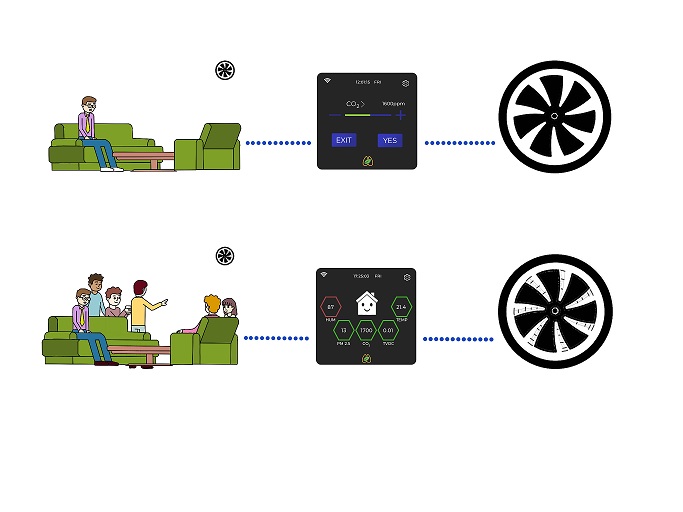Indoor air quality (IAQ) is a critical aspect of our daily lives, influencing our health, comfort, and overall well-being. The presence of pollutants, particularly carbon dioxide (CO2), can have a profound impact on the quality of the air we breathe. In recent years, the use of CO2 gas analyzers has become increasingly essential in managing indoor air quality. This blog explores the significance of CO2 gas analyzers and their role in ensuring a healthier and more comfortable indoor environment.
Understanding CO2 and Its Impact on Indoor Air Quality:
Carbon dioxide is a naturally occurring gas produced through various processes, including human respiration, combustion, and decomposition. While CO2 itself is not harmful in moderate concentrations, elevated levels can indicate poor ventilation and the potential presence of other pollutants. Common indoor sources of CO2 include humans, pets, and certain household appliances. Monitoring CO2 levels is crucial, as excessive concentrations can lead to discomfort, drowsiness, and, in extreme cases, negative health effects.
CO2 Gas Analyzers: The Guardians of Indoor Air Quality
CO2 gas analyzers, also known as CO2 sensors or meters, play a vital role in maintaining optimal indoor air quality. These devices measure and quantify the concentration of carbon dioxide in the air, providing valuable data to assess and manage ventilation systems. The key functions of CO2 gas analyzers in indoor air quality management include:
- Real-Time Monitoring:
- CO2 gas analyzers offer real-time monitoring capabilities, allowing users to track CO2 levels continuously. This instant feedback is essential for identifying trends, patterns, and potential sources of elevated CO2 concentrations.
- Ventilation Control:
- By providing accurate data on CO2 levels, gas analyzers enable precise control of ventilation systems. This helps ensure that fresh outdoor air is appropriately introduced into indoor spaces, preventing the buildup of CO2 and other pollutants.
- Occupancy Sensing:
- CO2 levels can serve as a proxy for occupancy. Analyzers can detect variations in CO2 concentrations, signaling changes in the number of occupants. This information can be used to optimize ventilation rates based on actual occupancy, enhancing energy efficiency.
- Health and Productivity Benefits:
- Maintaining optimal CO2 levels contributes to a healthier and more comfortable indoor environment. Studies have shown that improved indoor air quality, including proper CO2 management, can lead to increased productivity, reduced absenteeism, and overall well-being.
- Early Detection of Issues:
- CO2 gas analyzers can act as early warning systems, signaling potential issues with ventilation or the presence of indoor pollutants. Timely detection allows for proactive measures to address problems before they escalate.
- Compliance Monitoring:
- In certain settings, such as commercial buildings or educational institutions, compliance with indoor air quality standards is crucial. CO2 gas analyzers help ensure that ventilation systems meet regulatory requirements, providing a safe and healthy environment for occupants.
Applications Across Various Sectors:
The versatility of CO2 gas analyzers makes them invaluable across a wide range of sectors:
- Commercial Buildings:
- In offices, malls, and other commercial spaces, CO2 gas analyzers help maintain a comfortable environment for occupants. They contribute to energy efficiency by optimizing ventilation based on actual occupancy.
- Educational Institutions:
- Schools and universities benefit from CO2 monitoring to create conducive learning environments. Proper ventilation is essential to support cognitive function and the overall well-being of students and staff.
- Healthcare Facilities:
- Hospitals and clinics prioritize air quality to safeguard patient health. CO2 gas analyzers assist in maintaining sterile environments and preventing the spread of airborne contaminants.
- Residential Spaces:
- In homes, CO2 gas analyzers are useful tools for optimizing indoor air quality. They provide homeowners with the information needed to make informed decisions about ventilation and HVAC system usage.
- Manufacturing and Industrial Settings:
- In industrial settings, where air quality may be impacted by manufacturing processes, CO2 gas analyzers aid in compliance monitoring and ensuring the safety of workers.
Conclusion:
CO2 gas analyzers are integral to the modern approach to indoor air quality management. These devices empower individuals and organizations to make informed decisions about ventilation, creating healthier, more comfortable indoor environments. As we prioritize health and well-being, the role of CO2 gas analyzers in maintaining optimal indoor air quality has never been more critical. Investing in these technologies is a step towards a future where every breath we take contributes to our overall wellness.

